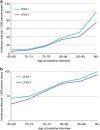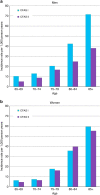A two decade dementia incidence comparison from the Cognitive Function and Ageing Studies I and II
- PMID: 27092707
- PMCID: PMC4838896
- DOI: 10.1038/ncomms11398
A two decade dementia incidence comparison from the Cognitive Function and Ageing Studies I and II
Abstract
Dramatic global increases in future numbers of people with dementia have been predicted. No multicentre population-based study powered to detect changes over time has reported dementia incidence. MRC Cognitive Function and Ageing Study (CFAS) undertook baseline interviews in populations aged 65+ years in England and Wales (1989-1994). Three areas (CFAS I) were selected for new sampling two decades later (2008-2011) with same geographical boundaries, sampling and approach methods (CFAS II). At 2 years CFAS I interviewed 5,156 (76% response) with 5,288 interviewed in CFAS II (74% response). Here we report a 20% drop in incidence (95% CI: 0-40%), driven by a reduction in men across all ages above 65. In the UK we estimate 209,600 new dementia cases per year. This study was uniquely designed to test for differences across geography and time. A reduction of age-specific incidence means that the numbers of people estimated to develop dementia in any year has remained relatively stable.
Figures




Comment in
-
Incidence of dementia in UK men is lower than previously estimated.BMJ. 2016 Apr 19;353:i2258. doi: 10.1136/bmj.i2258. BMJ. 2016. PMID: 27094819 No abstract available.
References
-
- Prince M. et al.. World Alzheimer Report 2015: The Gobal Impact of Dementia ana analysis of prevalence, incidence, cost and trends http://www.alz.co.uk/research/WorldAlzheimerReport2015.pdf (2015).
-
- Prince M. et al.. Dementia UK: Update Second Edition. http://www.alzheimers.org.uk/site/scripts/download_info.php?fileID=2323 (2014).
-
- Lewis F. Estimation of future cases of dementia from those born in 2015 http://cdn.dementiablog.org/wp-content/uploads/2015/09/OHE_Consulting_AR... (2015).
-
- Prince M. et al.. The global prevalence of dementia: a systematic review and metaanalysis. Alzheimers Dement 9, 63 (2013). - PubMed
Publication types
MeSH terms
Grants and funding
LinkOut - more resources
Full Text Sources
Other Literature Sources
Medical
Molecular Biology Databases

